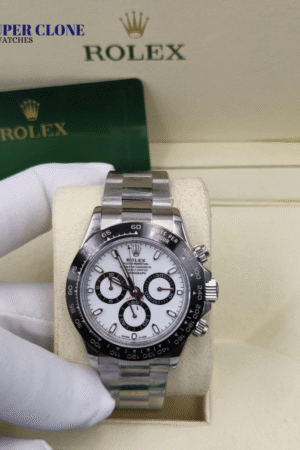In the world of luxury watches, Rolex stands as a symbol of precision, prestige, and timeless design. Unfortunately, this iconic status has made Rolex one of the most counterfeited watch brands on the planet. Today’s counterfeit market has evolved beyond the cheap fakes of the past—enter the era of the Rolex super clones.” These replicas are crafted with alarming accuracy, sometimes fooling even seasoned collectors. This guide will help you navigate the subtle, critical differences between a genuine Rolex and a high-end super clone.
Understanding What a “Super Clone” Really Is
A super clone isn’t your average knockoff. While traditional counterfeit watches often look cheap and feel flimsy, super clones are built using high-grade materials, advanced manufacturing techniques, and even custom-made movements designed to mimic Rolex’s mechanisms. Some are produced using 1:1 measurements from genuine watches, making them almost indistinguishable at first glance.
Unlike standard fakes, which a quick glance might expose, spotting a super clone requires careful inspection, sometimes even professional evaluation.
The Weight and Feel in Hand
One of the first giveaways is how the watch feels in your hand. Rolex uses 904L stainless steel—a material denser and more corrosion-resistant than the common 316L steel used in most replicas. This gives a genuine Rolex a noticeable heft.
A super clone may still use 316L but match the weight with added components, so while heft is a clue, it’s not always definitive. Instead, pay attention to balance: a genuine Rolex feels solid and evenly weighted, while a clone may feel slightly off-center in distribution.
The Dial and Printing Precision
The dial of a Rolex is a masterpiece of microscopic detail. Under magnification, the text on a genuine Rolex dial is crisp, perfectly aligned, and Super clones watches in usa free of ink bleed. The minute markers are evenly spaced, and the font consistency is flawless.
High-end super clones come close but often reveal imperfections when inspected under a jeweler’s loupe. Letter spacing may be microscopically inconsistent, the coronet logo may be a hair thicker or thinner, and the luminous plots might have uneven edges.
The Movement and Second-Hand Sweep
Rolex watches are renowned for their smooth, almost gliding second-hand motion, achieved through their high-beat movements (28,800 vibrations per hour). While a super clone may replicate this visually, the difference emerges in precision and longevity.
On a genuine Rolex, the sweep is buttery and consistent. In some super clones, you might notice the faintest irregularity or “stutter” when observed closely. Opening the caseback will reveal the ultimate truth: Rolex movements are immaculately finished with proprietary engravings, while clones—though often decorated—rarely match the same standard of finishing.
Cyclops Lens and Date Magnification
The Cyclops lens, a small magnifying lens over the date window, is a hallmark Rolex feature. Genuine Rolex watches have a 2.5x magnification, making the date bold and easy to read. Many super clones get close, but often land around 2x magnification, making the date slightly smaller than it should appear.
Additionally, the clarity of the sapphire and anti-reflective coating in genuine models provides a distortion-free view, something that even top-tier replicas sometimes fail to perfect.
Engravings and Micro-Details
At six o'clock on the crystal, modern Rolex watches have laser-etched crowns, a detail that is nearly imperceptible to the unaided eye. Real etchings are precisely placed and incredibly crisp. This feature is frequently present in super clones, however the etching may be a little off-center or not as clear when magnified.
Examine the rehaut (the inner bezel ring) writing, clasp stamps, and caseback engravings. Even the greatest reproductions might have subtle misalignments in the rehaut engraving, which is precisely in line with the hour markings on genuine Rolex watches.
Bracelet and Clasp Construction
A Rolex bracelet is a blend of comfort and engineering. The links articulate smoothly with no sharp edges, and the clasp mechanism operates with a satisfying, solid click. Super clones can mimic the look but may feel stiffer or looser, and the clasp might not close with the same precision.
Even the brushing and polishing of the bracelet links can give clues—the transitions on a genuine Rolex are immaculate, while a clone may have slightly uneven finishes.
Why Authentication Still Matters
Even armed with all this knowledge, the reality is that some super clones are nearly impossible to spot without opening the watch and examining the movement. This is why authentication by a trusted watchmaker or authorized dealer is essential, especially for high-value purchases.
A professional can measure movement specifications, check for proprietary Rolex components, and verify materials using tools unavailable to most collectors.
Final Thoughts
The popularity of Rolex super clones is evidence of the brand's appeal as well as the sophistication of contemporary counterfeiters. This makes it harder than ever to recognize a fake, but it also emphasizes how important knowledge, perseverance, and close examination are.
When investing in a Rolex, keep in mind that authenticity is about maintaining the integrity, history, and workmanship of one of the most recognizable watchmakers in the world, not just about owning a luxury object. No matter how good the replica is, it will never be able to fully capture the essence that the real thing carries.
